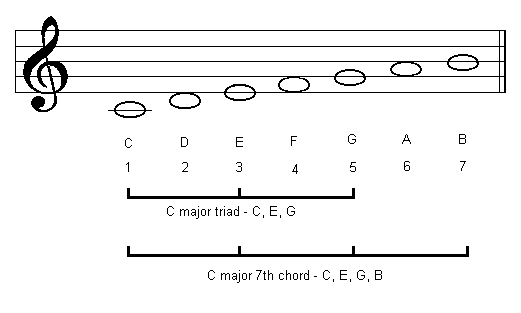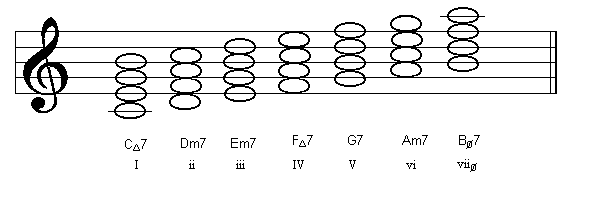
When we write out the C major scale on a staff, we start off this way. This figure shows which notes are used to make chords. The point is, to make chords, we only use the notes available to us in the scale. In a B-flat scale, for example, where the B and the E are flatted, then all the available chords that use a B or E use them flatted. Otherwise, the chords would be out of tune. To make the chords, we just pile the notes up thusly:

Using only the notes available in the scale, they form chords as shown on the figure. The first chord is a C major 7th. We call it I--the Roman numeral one in upper case because it is major. The second chord is a D minor 7th and we label it ii--or the Roman numeral two in lower case because it is minor. Note the sequence--I, ii, iii, IV, V, vi, vii. No matter which major scale you plot out, the chords will ALWAYS follow that sequence. What is notable is that the vii chord is always has a diminished 5th (it's 6 half-steps above the root or lowest note in the chord instead of the usual 7) and the V chord has a major triad (root-major third-fifth) but always uses a minor 7th instead of a major 7th as a true major chord would. Notice the true major chords are notated as the letter followed by a triangle and then the numeral 7. That's the symbol for a major 7th chord. The V chord is just a letter followed by a 7 or simply a 7th chord. A 7th chord is major-minor, i.e. a major triad topped by a minor 7th (it's 10 half-steps above the root instead of 11 as with a true major 7th chord). The V chord is extremely important as it usually resolves back to I in most songs and also allows us to change keys in a song.
Armed with this knowledge, here is the most useful circle of fifths chart I have seen:

Using this chart, suppose you run across a guitar piece that's in a key you can't play or can't sing in. How can you transpose it? Well, if you know what key you want to transpose it to, you would imagine the pointer on this chart highlighting that scale. Say it was in the key of G major. Then imagine sliding the point on C over one notch to G. G becomes I, A becomes ii, B becomes iii, C becomes IV, D becomes V and so on. Transposing a standard I-IV-V blues would be easy because they are lined up in a row on the circle. If we want to transpose a blues to the key of D-flat (although god only knows why we would), then D-flat is I, G-flat is IV and A-flat is V(7). Once you have the circle in your head, you can do it on the fly.